
One of the big reasons why Nishi lost in 2016 was that the student population it was supposed to serve with housing wasn’t convinced it was going to be affordable. Sean Raycraft, back in February, told the council, “I opposed the original Nishi project.”
He said “I didn’t think it was a good project. I didn’t think it was affordable for my members. I campaigned against it.”
The big difference now is first that the developers worked to create on-site affordable housing. Mr. Raycraft said, meanwhile, in the last two years, “the housing crisis has gotten worse.”
This is the tide that the opponents of Nishi will have to steer through – the perception among students that the housing crisis is the biggest issue facing the community and the fact that Nishi, along with Lincoln40, represent the first projects to address the issue of affordable housing for students.
Against this backdrop, it seems at least a little surprising that the Nishi opponents would want to stir up the student population and motivate them even more than they are already motivated to come out. But reading between the lines of their argument against the affordable housing proposal, we see a strategy that could create a huge backlash in a contest that figures to be tight.
The ballot argument appears to be the first step. They argue: “The proposed ‘affordable housing’ program is exclusionary, intended only for students, and to be implemented by the landlord. This  is contrary to the city’s long-standing affordable housing policies.”
is contrary to the city’s long-standing affordable housing policies.”
Conventional wisdom is that the strongest issue in the opponents’ pockets – perhaps the only really clear issue – is air quality. Affordable housing would seem to be a feather in the cap of the Yes on Nishi side.
But there is a school of thought that you attack proposals not on their weak points but on their strengths. The opposition is seeking to perhaps create a wedge between students and the older voters. It is a strategy that could work, but it is risky.
It is a continuation of the notion that student housing projects are exclusionary by design. In December, Eileen Samitz wrote of “mega-dorms,” saying, “These proposals would add up to 5,000 to 6,000 student beds in projects that are exclusionary by design because they are predominantly four- and five-bedroom apartment suites renting by the bed, with individual bathrooms.”
The idea there is that the city should not focus on student housing projects, but rather “any new multi-family housing needs, to have an inclusive design that suits all renters.”
But, while the general argument against student housing certain has attracted some support, the argument against student affordable housing is more tricky.
The first problem you have is that when you talk about “affordable housing” in general, you are already talking about exclusionary housing. By definition, affordable housing programs are designed to serve a specific population – a population of low income residents. That could be people living at or below the poverty line or it could be people making 120 percent or less of average median income.
That point aside, there is an even larger problem, when they are talking about the fact that the affordable housing is “intended only for students” and argue “this is contrary to the city’s long-standing affordable housing policies.”
They forget that traditional affordable housing programs do not serve students at all. Students generally do not qualify for those programs. As staff notes: “Student households are generally not eligible to occupy affordable housing financed with state or federal subsidies.”
That means if you are arguing that we need to have traditional affordable housing programs that are inclusionary, you are actually by definition precluding students from participating – which is a form of exclusionary process.
In most of the city, students are not eligible for affordable housing. Nishi along with Lincoln40 are two exceptions. They have created a model where they use private funding, internally generated to subsidize lower income students. So now instead, of paying $950 for their own room and $800 for a shared room, they pay between $400 and $570 for an affordable room.
For students who are struggling to pay rent, students whose parents do not have the resources to help, Nishi could be a life saver. That is a real benefit to one of the most vulnerable populations we have – low income students.
Do opponents of Nishi really want to fight that battle?
The implications of that argument are that we should not provide affordable housing to students in this community. That is what they are in effect arguing.
Can opponents convince older residents who are concerned about affordable housing for all by using this argument? Perhaps, but they come across as anti-student in the process and that is risky.
At the February council meeting, Councilmember Lucas Frerichs said, “This is an innovative path forward.” He added that it is “trying to get the access and true affordability for students which has not been done before.”
For Aaron Latta, an emerging student leader, he said that the affordable housing plan for Nishi was “beyond my expectations” and he was “amazed by the affordable housing plan for Lincoln40.”
Is this really the aspect of the program that the opponents want to draw attention to? Do they really want to convince students that they believe there should not be affordable housing for students?
That is where this is headed. An innovative program that would provide students with affordable housing is under attack here in Davis, because it is intended for students when most affordable housing programs cannot serve most students at all. And people wonder why students believe this community is anti-student.
—David M. Greenwald reporting







Clearly, I agree with this reasoning.